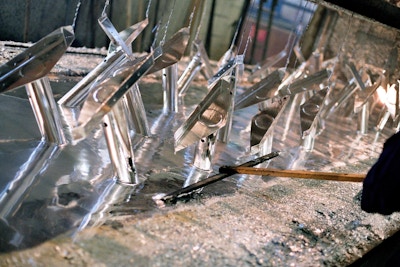
Hot-dip galvanisation
dddd
Vestre standard, self-healing sink
If the surface is damaged, hot-dip products repair themselves by shrinking the zinc and forming a new coating in the damaged area. This is called cathodic protection.
International standard, powder-coated steel
When the powder-coated surface is damaged, the steel will rust and the rust will spread under the lacquer. Then bubbles that you often see on older cars will arise and eventually burst so that the rust becomes visible.

Hot-dip galvanisation
All steel components used by Vestre are hot-dip galvanised in a liquid zinc bath at 450 °C / 840 °F. The bath is exclusively heated using renewable energy, meaning zero emission of harmful greenhouse gases. This process provides a rust-free coating (80–120 μ) that enables Vestre's products to remain outdoors for several decades. Around 2–4 μ of the coating is lost in the first year as a consequence of use and climate impact and then the loss decreases to 1–2 μ per year. This guarantees a lifespan of at least 30–40 years outdoors. Steel that is powder-coated after hot-dip galvanising will have an even longer lifespan, as the powder coating protects the zinc. If the surface is damaged, hot-dip galvanised products repair themselves through the zinc contracting and forming a new coating in the damaged area. This is called cathodic protection. Hot-dip galvanising is a method that was patented by the French engineer Sorel in 1837, and which these days is carried out in accordance with the strict environmental requirements defined in ISO 1461. Zinc (Zn) is an important renewable construction material that occurs naturally in stone, water and human beings.